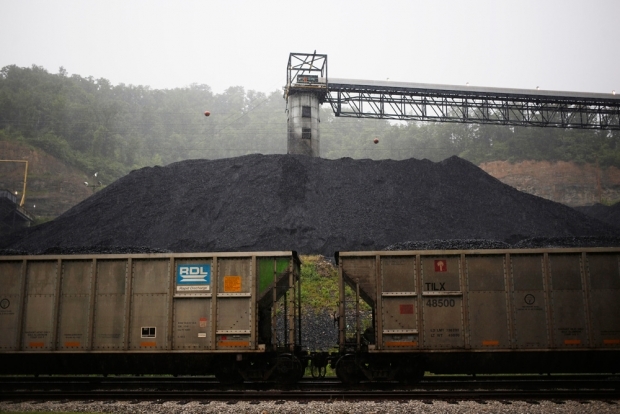Nearly everyone agrees that the U.S.-China climate announcement is a big deal, but most observers have overlooked what truly makes it a game-changer: if the world’s two climate change superpowers limit their greenhouse gas emissions, it will have the economic effect of putting a de facto price on carbon. The resulting increase in the market price of oil, coal, natural gas, and other carbon-based fuels really could change everything. But this will only happen if the two superpowers make good on their promises: if the U.S. refrains from pursuing such carbon-intensive projects as the Keystone XL oil pipeline and China does indeed peak its coal consumption by 2020, as the energy plan released by the State Council on November 19 forecast.
U.S. and China’s total energy consumption for 1990-2013, and China’s projected increase by 2030
It’s Economics 101: limit the supply of a commodity—in this case, the authority to emit carbon pollution—and its price rises. China and the U.S. together account for 45 percent of the world’s annual greenhouse gas emissions, giving them immense market influence. The world’s third-largest economic and climate superpower, the European Union, is pursuing even more ambitious emissions reductions than the U.S. and China. Consider also that ExxonMobil and scores of other global companies assume that a global price on carbon is inevitable; as Bloomberg Businessweek reports, ExxonMobil executives already test the profitability of long-term investments against the company’s “shadow” prices of $60 per ton by 2030 and $80 per ton by 2040. If China and the U.S. limit their emissions, a de facto price on carbon will become a reality in markets the world over.
The crucial caveat is that the U.S. and China must actually carry out their promised reductions. Otherwise, markets will discount their promises. This presents President Obama, in particular, with a challenge.
On November 18, Republicans and a handful of Democrats in the U.S. Senate came within one vote of passing a bill that would authorize the construction of Keystone XL, the pipeline that would carry carbon-dense oil from Canada to refineries on the Gulf Coast. Mitch McConnell of Kentucky, the incoming Senate Majority Leader, pledged to re-introduce the bill in January, when the 2014 election results will have put at least seven additional Republicans in the Senate. If Obama wants his climate deal with China to have lasting force, he will have to veto this bill and, for that matter, any other measures that encourage substantial additional carbon-based fuel production. The U.S. cannot credibly pledge to reduce emissions if it approves pipelines and other projects that would dramatically increase them.
Meanwhile, the inconvenient truth remains that the reductions enumerated in the U.S.-China deal do not go nearly far enough to limit global temperature rise to the international goal of 2 degrees Celsius. (China committed to cap emissions by 2030, allowing emissions to increase until then; the U.S. promised to reduce emissions by 26 to 28 percent by 2025, compared to 2005 levels.) Which is why this deal between Beijing and Washington must be only the first in a series of agreements that become more ambitious and comprehensive over time.
A useful parallel can be drawn to the last time civilization faced an existential threat. The first nuclear weapons agreement between the U.S. and the Soviet Union in the 1980s did not come close to delivering full disarmament. What it did was break a long-standing stalemate between the two superpowers and help to build the trust, momentum, and public support that made possible second, third, and fourth agreements that eventually did halt and reverse the arms race.
The climate agreement Presidents Obama and Xi made on November 11 broke the stalemate that had blocked international progress for decades. Now, the way is open to press Beijing and Washington to go further, and bring other nations with them, first at negotiations in Peru in December, and later at the Global Climate Summit in Paris in 2015.
That may sound like a tall order, but the coming de facto carbon price makes it plausible. A rising carbon price will increase prices of oil, coal, and other carbon-based energy, leading consumers, producers, and investors to increase their demand for alternative energy sources. This increased demand for solar panels, wind turbines, efficient buildings, and the like will spur their increased production. This, in turn, will enable economies of scale that push prices lower. These lower prices will then stimulate more demand, reinforcing the cycle and widening alternative energy’s competitive advantage over carbon-based fuels.
By 2030, China will use more energy than these countries do today, combined
Globally, alternative energy is already near a tipping point, with both the U.S. and China dramatically increasing investment, production, and deployment of solar and wind in particular. The costs of wind and solar are plummeting. The additional boost provided by a de facto carbon price could push alternatives ahead for good.
As solar, wind, and other alternatives get relatively cheaper, their market shares should expand and, crucially, give rise to political constituencies that benefit accordingly, providing political cover for the President’s climate change agenda. Republicans in Washington may still treat denial of climate change as a litmus test, but quite a few reddish states have robust clean energy sectors. Iowa gets 27 percent of its electricity from wind; Kansas gets 19 percent and Colorado 14 percent. If small business owners, farmers, and local public officials continue to embrace alternative energy, it will be hard for a future president or Congress to undo these gains.
Conversation
11.19.14
Was the U.S.-China Climate Deal Worth the Wait?
Of course, none of these outcomes is inevitable. If Obama fails to veto the next Keystone bill, or a fresh crisis in the Middle East causes gasoline prices to jump, or China’s leadership scales back its ambitions for limiting carbon emissions, the U.S.-China climate deal could still end up a mere footnote to history.
There were plenty of naysayers in the early stages of the U.S.-Soviet arms negotiations, too, and events proved them spectacularly wrong. History never repeats exactly. But in the case of climate change, even coming close could make a world of difference.




